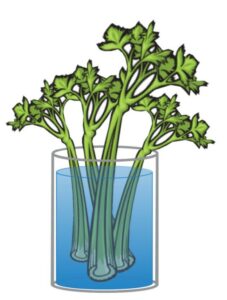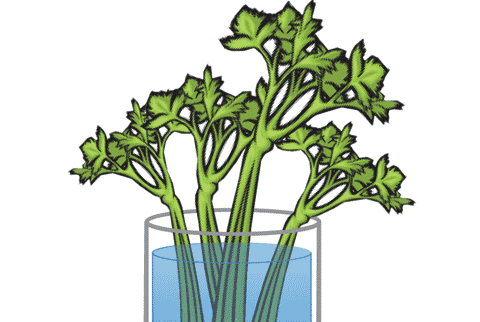Overview
STEM careers
Time
Materials
Per Class:
- 8 celery stalks
- Red or blue food coloring
- Water
- Paring knife
- 2 glass jars or beakers
- Paper towels for cleanup
Instructions
This simple experiment illustrates the power of plants to absorb dissolved chemicals from water.
Caution: For safety, be sure to inform participants not to taste or eat any of the materials during this activity.
 DAY 1:
DAY 1:
- Fill two glass jars or beakers with water.
- Add food coloring to the water until it turns a deep color. Explain that this water has now been polluted.
- Trim ends of the celery stalks so that they are freshly cut.
- Put the celery in the beakers, 4 per beaker, with the cut ends down. Encourage students to speculate about what will happen to the celery and to the water.
DAY 2:
- Divide the class into eight teams.
- Let the students see the celery in the jars, and then give each team one stalk of celery.
- Cut the celery so that each team member has a piece to examine; give students time to observe his or her piece.
Guiding questions
DAY 1:
- What will happen to the celery if we leave it in the jars for a whole day?
- What will happen to the water? The food coloring?
DAY 2:
- Why didn’t the celery absorb all the food coloring?
- If the water with food coloring represents polluted water, how does the celery represent what plants can do to make water cleaner?
Engineering & science connections
- Natural wetlands include areas like marshes and swamps. But engineers also design constructed wetlands to treat wastewater from domestic, agricultural, industrial, and mining processes. These wetlands use processes similar to celery absorption to take harmful chemicals out of water.
- Constructed wetlands have many benefits. They are sustainable, because they don’t need machines or added energy to do their work. They also create wildlife habitat and can assist in controlling flooding.
- Constructed wetlands are an example of how engineers learn from nature, using nature’s designs to inspire their own designs. Other examples of engineering designs inspired by nature include:
- airplanes (informed by birds)
- Velcro (informed by plant burrs)
- submarines (informed by fish)
- wind turbines (informed by trees)
This activity was provided by CH2M HILL (ch2m.com) and the Water Environment Federation (wef.org) for National Engineers Week 2000.


0 Comments